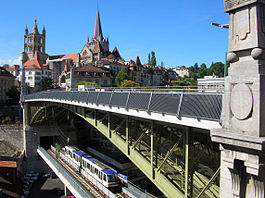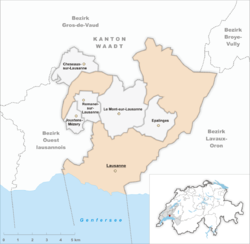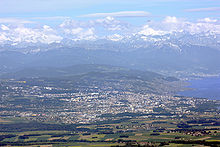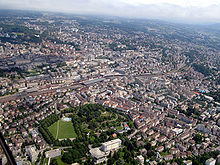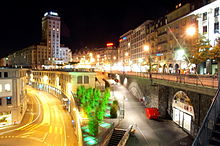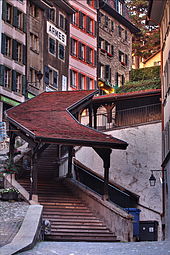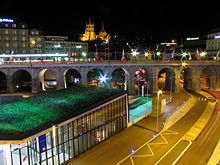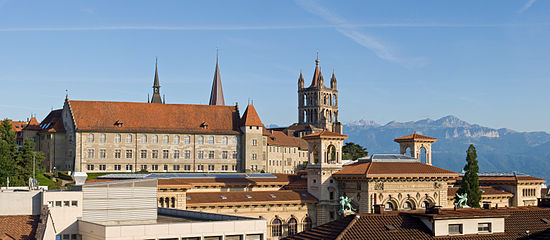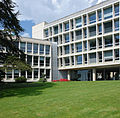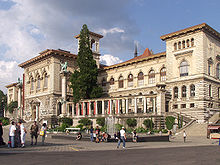- Lausanne
-
For other uses, see Lausanne (disambiguation).
Lausanne Lausanne Cathedral and old town Country Switzerland 
Canton Vaud District Lausanne 46°31.19′N 6°38.01′E / 46.51983°N 6.6335°ECoordinates: 46°31.19′N 6°38.01′E / 46.51983°N 6.6335°E Population 125,885 (Dec 2009)[1] - Density 3,043 /km2 (7,881 /sq mi) Area 41.38 km2 (15.98 sq mi)[2] Elevation 495 m (1,624 ft) - Highest 929.4 m - Jorat - Lowest 372 m - Lake Geneva Postal code 1000-1018 SFOS number 5586 Mayor (list) Daniel Brélaz (as of 2008) GPS Demonym Les Lausannois Localities Le Chalet-à-Gobet, Montblesson, Montheron, Ouchy, Vernand-Dessous, Vernand-Dessus, Vers-chez-les-Blanc Surrounded by Bottens, Bretigny-sur-Morrens, Chavannes-près-Renens, Cheseaux-sur-Lausanne, Crissier, Cugy, Ecublens, Epalinges, Évian-les-Bains (FR-74), Froideville, Jouxtens-Mézery, Le Mont-sur-Lausanne, Lugrin (FR-74), Maxilly-sur-Léman (FR-74), Montpreveyres, Morrens, Neuvecelle (FR-74), Prilly, Pully, Renens, Romanel-sur-Lausanne, Saint-Sulpice, Savigny Website www.lausanne.ch
Profile, SFSO statisticsLausanne (French pronunciation: [loˈzan]) is a city in Romandy, the French-speaking part of Switzerland, and is the capital of the canton of Vaud. The seat of the district of Lausanne, the city is situated on the shores of Lake Geneva (French: Lac Léman).[3] It faces the French town of Évian-les-Bains, with the Jura mountains to its north-west. Lausanne is located 62 km (39 mi) northeast of Geneva.
Lausanne has a population (as of December 2009[update]) of 125,885,[1] making it the fourth largest city of the country, with the entire agglomeration area having over 330,000 inhabitants.[4] The Metropolitan Area of Lausanne-Geneva is over 1.2 million inhabitants. The headquarters of the International Olympic Committee are located in Lausanne – the IOC officially recognises the city as the Capitale Olympique[5] – as are the headquarters of the Court of Arbitration for Sport. It lies in the middle of a wine region. The city has a 28-station metro system, making it the smallest city in the world to have a rapid transit system.[citation needed]
Contents
History
The Romans built a military camp, which they called Lousanna, at the site of a Celtic settlement, near the lake where currently Vidy and Ouchy are situated; on the hill above was a fort called 'Lausodunon' or 'Lousodunon' (The 'y' suffix is common to many place names of Roman origin in the region (e.g.) Prilly, Pully, Lutry, etc.).[6] By the 2nd century AD it was known as vikanor[um] Lousonnensium and in 280 as lacu Lausonio. By 400 it was civitas Lausanna and in 990 it was mentioned as Losanna.[7]
After the fall of the Roman Empire, insecurity forced the transfer of Lausanne to its current centre, a hilly, easier to defend site. The city which emerged from the camp was ruled by the Dukes of Savoy and the Bishop of Lausanne. Then it came under Bern from 1536 to 1798 and a number of its cultural treasures, including the hanging tapestries in the Cathedral, were permanently removed. Lausanne has made a number of requests to recover them.
After the revocation of the Edict of Nantes in 1685, Lausanne became (along with Geneva) a place of refuge for French Huguenots. In 1729 a seminary was opened by Antoine Court and Benjamin Duplan. By 1750 ninety pastors had been sent back to France to work clandestinely; this number would rise to four hundred. Official persecution ended in 1787; a faculty of Protestant theology was established at Montauban in 1808, and the Lausanne seminary was finally closed on 18 April 1812.[8] During the Napoleonic Wars, the city's status changed. In 1803, it became the capital of a newly formed Swiss canton, Vaud under which it joined the Swiss Federation.[9]
Modern history
In 1964 the city hosted the 'Swiss National Exhibition',[10] displaying its newly found confidence to host major international events. From the 1950s to 1970s a large number of Italians, Spaniards and Portuguese immigrated, settling mostly in the industrial district of Renens and transforming the local diet.
The city has been traditionally quiet but in the late 1960s and early 1970s there were a series of mainly youth demonstrations confronted by the police. The next vigorous demonstrations took place to protest against the high cinema prices and since then the city returned to its old very sleepy self, until the protest against the G8 meetings in 2003.
Geography
The most important geographical feature of the area surrounding Lausanne is Lake Geneva (Lac Léman in French). Lausanne is built on the southern slope of the Swiss plateau, with a difference in elevation of about 500 metres (1,640 ft) between the lakeshore at Ouchy and its northern edge bordering Le Mont-sur-Lausanne and Epalinges. Lausanne boasts a dramatic panorama over the lake and the Alps.
In addition to its generally southward-sloping layout, the centre of the city is the site of an ancient river, the Flon, which has been covered since the 19th century. The former river forms a gorge running through the middle of the city south of the old city centre, generally following the course of the present Rue Centrale, with several bridges crossing the depression to connect the adjacent neighbourhoods. Due to the considerable differences in elevation, visitors should make a note as to which plane of elevation they are on and where they want to go, otherwise they will find themselves tens of metres below or above the street which they are trying to negotiate. The name Flon is also used for the Metro station located in the gorge.
The municipality includes the villages of Vidy, Cour, Ouchy, Mornex, Chailly, La Sallaz, Vennes, Montblesson, Vers-chez-les-Blanc, Montheron and Chalet-à-Gobet (871 m (2,858 ft)) as well as the exclave of Vernand.
Lausanne is located at the limit between the extensive wine-growing regions of Lavaux (to the east) and la Côte (to the west).
Lausanne has an area, as of 2009[update], of 41.38–41.33 square kilometers (15.98–15.96 sq mi) (depending on calculation method). Of this area, 6.64 km2 (2.56 sq mi) or 16.0% is used for agricultural purposes, while 16.18 km2 (6.25 sq mi) or 39.1% is forested. Of the rest of the land, 18.45 km2 (7.12 sq mi) or 44.6% is settled (buildings or roads), 0.05 km2 (12 acres) or 0.1% is either rivers or lakes and 0.01 km2 (2.5 acres) or 0.0% is unproductive land.[11]
Of the built-up area, industrial buildings made up 1.6% of the total area while housing and buildings made up 21.6% and transportation infrastructure made up 12.5%. Power and water infrastructure as well as other special developed areas made up 1.4% of the area while parks, green belts and sports fields made up 7.5%. Out of the forested land, all of the forested land area is covered with heavy forests. Of the agricultural land, 11.1% is used for growing crops and 4.2% is pastures. All the water in the municipality is in lakes.[11]
The municipality was part of the old Lausanne District until it was dissolved on 31 August 2006, and it became the capital of the new district of Lausanne.[12]
Coat of arms
The blazon of the municipal coat of arms is Gules, chief argent.[13]
Demographics
Lausanne has a population (as of December 2009[update]) of 125,885.[1] As of 2008[update], 39.1% of the population are resident foreign nationals.[14] Over the last 10 years (1999–2009 ) the population has changed at a rate of 9.9%. It has changed at a rate of 8.3% due to migration and at a rate of 2.6% due to births and deaths.[15] The population of the greater Lausanne area (grand Lausanne) is about 316,000 (2007 estimate).
Most of the population (as of 2000[update]) speaks French (98,424 or 78.8%), with German being second most common (5,365 or 4.3%) and Italian being third (4,976 or 4.0%). There are 62 people who speak Romansh.[16]
Of the population in the municipality 34,460 or about 27.6% were born in Lausanne and lived there in 2000. There were 18,697 or 15.0% who were born in the same canton, while 22,099 or 17.7% were born somewhere else in Switzerland, and 44,948 or 36.0% were born outside of Switzerland.[16]
In 2008[update] there were 840 live births to Swiss citizens and 623 births to non-Swiss citizens, and in same time span there were 862 deaths of Swiss citizens and 127 non-Swiss citizen deaths. Ignoring immigration and emigration, the population of Swiss citizens decreased by 22 while the foreign population increased by 496. There were 9 Swiss men and 57 Swiss women who emigrated from Switzerland. At the same time, there were 2230 non-Swiss men and 1802 non-Swiss women who immigrated from another country to Switzerland. The total Swiss population change in 2008 (from all sources, including moves across municipal borders) was an increase of 883 and the non-Swiss population increased by 2221 people. This represents a population growth rate of 2.6%.[14]
The age distribution, as of 2009[update], in Lausanne is; 11,818 children or 9.4% of the population are between 0 and 9 years old and 12,128 teenagers or 9.7% are between 10 and 19. Of the adult population, 21,101 people or 16.8% of the population are between 20 and 29 years old. 22,158 people or 17.6% are between 30 and 39, 18,016 people or 14.4% are between 40 and 49, and 13,940 people or 11.1% are between 50 and 59. The senior population distribution is 11,041 people or 8.8% of the population are between 60 and 69 years old, 8,277 people or 6.6% are between 70 and 79, there are 5,896 people or 4.7% who are between 80 and 89, and there are 1,171 people or 0.9% who are 90 and older.[17]
As of 2000[update], there were 58,100 people who were single and never married in the municipality. There were 48,990 married individuals, 7,797 widows or widowers and 10,027 individuals who are divorced.[16]
As of 2000[update] the average number of residents per living room was 0.64 which is about equal to the cantonal average of 0.61 per room.[15] In this case, a room is defined as space of a housing unit of at least 4 m² (43 sq ft) as normal bedrooms, dining rooms, living rooms, kitchens and habitable cellars and attics.[18] About 6.5% of the total households were owner occupied, or in other words did not pay rent (though they may have a mortgage or a rent-to-own agreement).[19]
As of 2000[update], there were 62,258 private households in the municipality, and an average of 1.9 persons per household.[15] There were 31,205 households that consist of only one person and 2,184 households with five or more people. Out of a total of 63,833 households that answered this question, 48.9% were households made up of just one person and there were 306 adults who lived with their parents. Of the rest of the households, there are 13,131 married couples without children, 11,603 married couples with children There were 3,883 single parents with a child or children. There were 2,130 households that were made up of unrelated people and 1,575 households that were made up of some sort of institution or another collective housing.[16]
In 2000[update] there were 1,833 single family homes (or 23.1% of the total) out of a total of 7,925 inhabited buildings. There were 3,634 multi-family buildings (45.9%), along with 1,955 multi-purpose buildings that were mostly used for housing (24.7%) and 503 other use buildings (commercial or industrial) that also had some housing (6.3%). Of the single family homes 324 were built before 1919, while 153 were built between 1990 and 2000. The greatest number of single family homes (498) were built between 1919 and 1945. The most multi-family homes (933) were built before 1919 and the next most (906) were built between 1919 and 1945. There were 180 multi-family houses built between 1996 and 2000.[20]
In 2000[update] there were 69,383 apartments in the municipality. The most common apartment size was 3 rooms of which there were 22,408. There were 9,579 single room apartments and 7,388 apartments with five or more rooms. Of these apartments, a total of 61,056 apartments (88.0% of the total) were permanently occupied, while 6,840 apartments (9.9%) were seasonally occupied and 1,487 apartments (2.1%) were empty.[20] As of 2009[update], the construction rate of new housing units was 2.1 new units per 1000 residents.[15]
As of 2003[update] the average price to rent an average apartment in Lausanne was 1064.08 Swiss francs (CHF) per month (US$850, £480, €680 approx. exchange rate from 2003). The average rate for a one room apartment was 597.46 CHF (US$480, £270, €380), a two room apartment was about 792.33 CHF (US$630, £360, €510), a three room apartment was about 1044.64 CHF (US$840, £470, €670) and a six or more room apartment cost an average of 2024.55 CHF (US$1620, £910, €1300). The average apartment price in Lausanne was 95.3% of the national average of 1116 CHF.[21] The vacancy rate for the municipality, in 2010[update], was 0.17%.[15]
Transport
See also: Lausanne railway station, Léman RER, and Lausanne MetroLausanne is served by extensive local, national and international public transport. National and international passenger trains depart from Lausanne's CFF railway station, which is also the hub of the Réseau Express Vaudois commuter rail system, and a stop on the city's metro. The metro and local buses are operated by TL (French), with many routes run using trolleybuses. Additional commuter trains are run by LEB (French) from Lausanne-Flon station. Ships across Lake Geneva are provided by CGN (French).
Lausanne became the first city in Switzerland to have a rubber-tyred metro system, with the m2 Line which opened in October 2008. The rolling stock is a shorter version of the one used on Paris Métro Line 14.[citation needed]
Lausanne is connected to the A1 motorway on its west side (Geneva - Zurich axis) and to the A9 on its north and east side (for transit with Italy and France); the interchange between these two motorways is on the north-west side of the city.
Lausanne Airport is located at Blécherette, and also houses a Boeing 737 Simulator.[22] The city is also directly linked by train to the Geneva International Airport, four times an hour, in 42min.
Historic Population
The historical population is given in the following chart:[7]

Historic Population Data [7] Year Total Population French Speaking German Speaking Catholic Protestant Other Jewish Islamic No religion given Swiss Non-Swiss 13th Century 8,000-9,000 1650–1680 ca. 5,100 1698 6,204 1764 7,191 1798 over 9,000 1813 ca. 13,000 1850 17,108 970 16,101 16,023 1,085 1870 25,845 3,527 22,596 22,353 4,167 1888 33,340 25,750 5,704 4,575 28,431 1,034 184 28,205 5,135 1900 46,732 35,509 6,627 9,364 36,659 1,450 473 37,231 9,501 1910 64,446 46,293 9,669 15,597 46,166 3,167 989 48,647 15,799 1930 75,915 58,691 11,080 16,868 56,300 2,901 818 65,231 10,684 1950 106,807 88,226 12,403 27,218 75,559 2,349 1,009 97,119 9,688 1970 137,383 101,555 11,964 54,993 75,093 11,670 1,394 669 2,056 106,229 31,154 1990 128,112 95,455 6,799 56,464 48,496 19,103 919 2,775 14,548 88,905 39,207 2000 124,914 98,424 5,365 47,225 36,084 16,149 849 7,501 21,080 80,213 44,701 Political situation
In the 2011 federal election the most popular party was the SP which received 30.14% of the vote (3 % up compard to 2007). The next three most popular parties were the SVP (14.98%), the FDP (14.70%) and the Green Party (13.60%). In the federal election, a total of 25,518 votes were cast, and the voter turnout was 40.3%.[23]
The city of Lausanne has a legislature, the City Council, with 100 members and an executive, the town hall with seven members. The legislature is elected by proportional representation from the Executive and the two-round majority system.
For the 2011-2016 legislative period, 100 members of the City Council Composition of the Municipal Council are distributed as follows:
- 29 Socialist Party
- 24 FDP.The Liberals
- 20 Green
- 14 Swiss People's Party
- 14 extreme left (POP, solidaritéS, the Left Bank)
The 7 members of the Town Hall are shared:
- 3 Socialist Party
- 2 Green
- 1 FDP.The Liberals
- 1 extreme left (POP)
The town has seven departments, each headed by a Municipal Councillor (period 2011-2016):
Photo of members of the municipality
- Daniel Brélaz (Green): general administration
- Oscar Tosato (Socialist Party): childhood, youth and social
- Marc Vuilleumier (POPs): public safety and sports
- Jean-Yves Pidoux (Green): industrial services
- Florence Germond (Socialist Party): finance and parks
- Gregory Junod (Socialist Party): culture and housing
- Olivier Français (FDP.The Liberals): Construction
Economy
As of 2010[update], Lausanne had an unemployment rate of 8%. As of 2008[update], there were 114 people employed in the primary economic sector and about 25 businesses involved in this sector. 6,348 people were employed in the secondary sector and there were 698 businesses in this sector. 83,157 people were employed in the tertiary sector, with 6,501 businesses in this sector.[15]
There were 59,599 residents of the municipality who were employed in some capacity, of which females made up 47.4% of the workforce. In 2008[update] the total number of full-time equivalent jobs was 75,041. The number of jobs in the primary sector was 93, of which 56 were in agriculture, 34 were in forestry or lumber production and 3 were in fishing or fisheries. The number of jobs in the secondary sector was 6,057 of which 1,515 or (25.0%) were in manufacturing, 24 or (0.4%) were in mining and 3,721 (61.4%) were in construction. The number of jobs in the tertiary sector was 68,891. In the tertiary sector; 8,520 or 12.4% were in the sale or repair of motor vehicles, 2,955 or 4.3% were in the movement and storage of goods, 4,345 or 6.3% were in a hotel or restaurant, 4,671 or 6.8% were in the information industry, 6,729 or 9.8% were the insurance or financial industry, 8,213 or 11.9% were technical professionals or scientists, 5,756 or 8.4% were in education and 14,312 or 20.8% were in health care.[24]
In 2000[update], there were 55,789 workers who commuted into the municipality and 19,082 workers who commuted away. The municipality is a net importer of workers, with about 2.9 workers entering the municipality for every one leaving. About 1.9% of the workforce coming into Lausanne are coming from outside Switzerland, while 0.1% of the locals commute out of Switzerland for work.[25] Of the working population, 40.9% used public transportation to get to work, and 35.1% used a private car.[15]
- Philip Morris International, a tobacco company, has its international headquarters in Lausanne.[26]
- Tetra Laval, a multinational packaging corporation, has its international headquarters in Lausanne.
- Nestlé, a multinational food and nutrition corporation, with international headquarters in Vevey, next to Lausanne.
Religion
From the 2000 census[update], 47,225 or 37.8% were Roman Catholic, while 33,993 or 27.2% belonged to the Swiss Reformed Church. Of the rest of the population, there were 2,698 members of an Orthodox church (or about 2.16% of the population), there were 65 individuals (or about 0.05% of the population) who belonged to the Christian Catholic Church, and there were 4,437 individuals (or about 3.55% of the population) who belonged to another Christian church. There were 849 individuals (or about 0.68% of the population) who were Jewish, and 7,501 (or about 6.00% of the population) who were Islamic. There were 452 individuals who were Buddhist, 772 individuals who were Hindu and 343 individuals who belonged to another church. 21,080 (or about 16.88% of the population) belonged to no church, are agnostic or atheist, and 7,590 individuals (or about 6.08% of the population) did not answer the question.[16]
Weather
Lausanne has an average of 123 days of rain or snow per year and on average receives 1,150 mm (45 in) of precipitation. The wettest month is June during which time Lausanne receives an average of 117 mm (4.6 in) of rain. During this month there is precipitation for an average of 10.8 days. The month with the most days of precipitation is May, with an average of 12.4, but with only 107 mm (4.2 in) of rain or snow. The driest month of the year is February with an average of 78 mm (3.1 in) of precipitation over 10.2 days.[27]
Education
 The École Polytechnique Fédérale de Lausanne (photo) and the University of Lausanne form a large campus near the lake Geneva
The École Polytechnique Fédérale de Lausanne (photo) and the University of Lausanne form a large campus near the lake Geneva
In Lausanne about 40,118 or (32.1%) of the population have completed non-mandatory upper secondary education, and 22,934 or (18.4%) have completed additional higher education (either university or a Fachhochschule). Of the 22,934 who completed tertiary schooling, 38.7% were Swiss men, 31.3% were Swiss women, 17.1% were non-Swiss men and 12.9% were non-Swiss women.[16]
In the 2009/2010 school year there were a total of 12,244 students in the Lausanne school district. In the Vaud cantonal school system, two years of non-obligatory pre-school are provided by the political districts.[28] During the school year, the political district provided pre-school care for a total of 2,648 children of which 1,947 children (73.5%) received subsidized pre-school care. The canton's primary school program requires students to attend for four years. There were 6,601 students in the municipal primary school program. The obligatory lower secondary school program lasts for six years and there were 5,244 students in those schools. There were also 399 students who were home schooled or attended another non-traditional school.[29]
Lausanne is home to a number of museums including; the Collection de l'Art brut, the Espace Arlaud, the Fondation de l'Hermitage, the Musée cantonal d'archéologie et d'histoire, the Musée cantonal de géologie, the Musée cantonal de zoologie, the Musée cantonal des Beaux-Arts, the Musée de design et d'arts appliqués contemporains, the Musée de l'Elysée and the Musée historique de Lausanne.[30] In 2009 the Collection de l'Art brut was visited by 27,028 visitors (the average in previous years was 33,356). The Espace Arlaud was visited by 9,222 visitors (the average in previous years was 14,206). The Fondation de l'Hermitage was visited by 89,175 visitors (the average in previous years was 74,839). The Musée cantonal d'archéologie et d'histoire was visited by 14,841 visitors (the average in previous years was 15,775). The Musée cantonal de zoologie was visited by 30,794 visitors (the average in previous years was 30,392). The Musée cantonal de géologie was visited by 28,299 visitors (the average in previous years was 24,248). The Musée cantonal des Beaux-Arts was visited by 26,456 visitors (the average in previous years was 26,384). The Musée de design et d'arts appliqués contemporains was visited by 28,554 visitors (the average in previous years was 22,879). The Musée de l'Elysée was visited by 36,775 visitors (the average in previous years was 37,757). The Musée historique de Lausanne was visited by 23,116 visitors (the average in previous years was 22,851).[30]
As of 2000[update], there were 12,147 students in Lausanne who came from another municipality, while 2,258 residents attended schools outside the municipality.[25]
Lausanne is home to 8 large libraries or collections of libraries. These libraries include; the BCU Lausanne, the Ecole Polytechnique Fédérale de Lausanne, the libraries of the Réseau EPFL, the Bibliothèque municipale Lausanne, the Haute école de travail social et de la santé (EESP), the HECV Santé, the Haute école de la santé La Source and the Ecole cantonale d'art de Lausanne - ECAL. There was a combined total (as of 2008[update]) of 3,496,260 books or other media in the libraries, and in the same year a total of 1,650,534 items were loaned out.[31]
Lausanne enjoys some world class education and research establishments, including private schools attended by students from around the world.
- École Polytechnique Fédérale de Lausanne - EPFL ("Swiss Federal Institute of Technology - Lausanne") - ranked 35th in the world according to 2011 QS world university rankings[citation needed]
- University of Lausanne (UNIL)
- University Hospital of Lausanne (CHUV), a hospital centre with associated research
- HEC Lausanne - Hautes études commerciales, (Faculty of Business and Economics of the University of Lausanne)
- Institute for Advanced Studies in Public Administration
- AISTS ("International Academy of Sports Science and Technology")
- BSL, Business School Lausanne
- International Institute for Management Development (IMD)
- École hôtelière de Lausanne
- The Lausanne campus of the university of the Nations
- Pepperdine University maintains an international study campus in Lausanne
Sights
Heritage sites of national significance
There are 46 buildings or sites that are listed as Swiss heritage site of national significance. Additionally, the entire old city of Lausanne and the Vernand-Dessus region are listed in the Inventory of Swiss Heritage Sites.[32]
- Religious Buildings: Notre-Dame Cathedral, Swiss Reformed Church of Saint-François, Swiss Reformed Church of Saint-Laurent and the Synagogue at Avenue de Florimont.
- Civic Structures: Former Hôpital at Rue Mercerie 24, Former Federal Tribunal, the Former Académie at Rue Cité-Devant 7, Casino de Montbenon, St-Maire Castle, Bois-de-Vaux Cemetery, Fondation de l’Hermitage and House de maître, Main Train Station, Hôtel Beau-Rivage Palace, City Hall, Hôtel des Postes, Administration Building of André & Cie. S.A., Administration Building of the Vaudoise Assurances, Apartment and Office Building at Rue du Grand-Chêne 8, Les Bains de Bellerive, l’Estérel House, House at Chemin de Chandolin 4, the Mon-Repos estate at Parc de Mon-Repos 1, Olympic Museum and Archives of the CIO, the vessels of the CGN (La Suisse (1910), Savoie (1914), Simplon (1920), Rhône (1927)), Pont Chauderon, the Vernand-Dessus rural site, Site de l’Expo 64 avec théatre de Vidy, the Tour Bel-Air and the Centre hospitalier universitaire vaudois (CHUV).
- Museums and Libraries: Former Residence of the Bishop of Lausanne which is now the Historical Museum of Lausanne, Bibliothèque des Cèdres (ancienne Library des pasteurs), Beaulieu Castle and the Collection de l’Art brut (Collection of Outsider art), Fondation Toms Pauli Collection de tapisseries and d’art textile, Galeries Saint-François, l’Elysée House and Museum, Museum de design and d’arts appliqués contemporains (MUDAC), Cantonal Museum and Botanical Gardens, the Roman Museum, the Palais de Rumine with the Musée cantonal de géologie, Musée cantonal de zoologie, Musée Cantonal des Beaux-Arts, Musée monétaire cantonal (Cabinet des médailles) and Musée d’archéologie et d’histoire.
- Archives: Archives of the Banque Vaudoise, Archives of the City of Lausanne, Archives of l’Energie Ouest Suisse (EOS), the Radio Suisse Romande archives and the Tribunal Fédéral Suisse with Archives.
- Archeological sites: The roman era/medieval hill-top city and the prehistoric settlement and Roman era Vicus of Vidy / Lousanna,
-
Swiss Reformed Church of Saint-François
-
Swiss Reformed Church of Saint-Laurent
-
Olympic Museum and Archives of the CIO
Culture
The Orchestre de Chambre de Lausanne and the Ensemble Vocal de Lausanne provide a diverse and rich musical life. The latter has been under the direction of Michel Corboz for many years.
In January, the Prix de Lausanne, a famous dance competition, takes place at the Théâtre de Beaulieu over a one-week period. The event attracts dancers and some of the big names in dance from all over the world.
The town hosted the Eurovision Song Contest 1989.
Each July, the "Festival de la Cité" is held in the old part of town. There are also film and music festivals, such as the Lausanne Underground Film and Music Festival and the Bach Festival, Le Festival et Concours Bach de Lausanne, which follows "La Nuit de Musées" (museums' night, occurring in May) in the fall season.
Lausanne is also the home of the Béjart Ballet.
Monuments
- Lausanne Cathedral (restored by Viollet-le-Duc).
- Hôtel de Ville
- Drazen Petrovic - Monument of famous Croatian (and former Yugoslavian) Basketball Champion
Museums
Lausanne is also the site of many museums:
- Musée Olympique Lausanne ("Olympic Museum")
- Musée de l'Elysée ("Elysée Museum")
- Fondation de l'Hermitage ("Hermitage Foundation")
- La Collection de l'Art Brut ("Art Brut" Collection)
- mudac (Musée de design et d'arts appliqués contemporains)
- Musée Historique de Lausanne ("Lausanne History Museum")
- Musée monétaire cantonal(French) (formerly Cabinet des Médailles cantonal, "Cantonal Money Museum" - short presentation in English)
- Espace Arlaud(French)
- Espace des Inventions(French) ("Science Center for Kids")
- Fondation Claude Verdan(French) - Musée de la main ("Museum of the Hand")
- Vivarium de Lausanne(French)
- Musée et jardins botaniques cantonaux(French) ("Cantonal Botanical Museum and Gardens" - short presentation in English)
- Musée cantonal d'Archéologie et d'Histoire(French) ("Cantonal Museum of Archeology and History" short presentation in English)
- Musée cantonal des Beaux-Arts(French) ("Cantonal Fine Arts Museum")
- Musée Cantonal de Zoologie
- Musée cantonal de Géologie(French) ("Cantonal Geological Museum")
- Musée romain de Lausanne-Vidy ("Lausanne-Vidy Roman Museum")
Art galleries
Main contemporary art galleries:
- Galerie Lucy Mackintosh
- Dubner Moderne
- Synopsism (French)
- Espace Saint-François (French)
Art centers or artist-run galleries:
- Circuit (French)
- Galerie Galerie 1m3
- Doll espace d'art contemporain (French)
Music
- Contemporary composer Leonardo Balada's Symphony No. 4 is subtitled 'Lausanne'.
- Igor Stravinsky's L'Histoire du Soldat was premiered in Lausanne in September 1918.
Sports
 The seat of the International Olympic Committee in Lausanne
The seat of the International Olympic Committee in Lausanne
Sporting activities are very popular in Lausanne, with water sports available on the nearby lake and mountaineering in the nearby mountains. Cycling is also a popular pastime, with the vineyards in the surrounding hills providing spectacular views and challenging routes. There is an annual track and field meeting (Athletissima), road running through the city (the 20 km de Lausanne(French)), the Tour de Romandie road cycling race, marathon (website) and triathlon competition, among other sports events. The two most important sports are ice hockey and football.
- Local
- Lausanne Hockey Club
- Lausanne-Sport Football Club
- Lausanne-Sports Aviron Rowing Club
- Lausanne Sharks American Football Club[citation needed]
- NSFL Non Professional Swiss Romand American Football Federation[citation needed]
- The Bandy Federation of Switzerland[33]
- Stade Lausanne Rugby Club[34]
- Lausanne Frisbee[35]
- International
- International Olympic Committee Headquarters
- Court of Arbitration for Sport Headquarters
- International Hockey Federation Headquarters
- International Table Tennis Federation Headquarters
- Fédération Aéronautique Internationale (FAI) The World Air Sports Federation
- Fédération Equestre Internationale (FEI) The international governing body for equestrian
- Fédération Internationale des Sociétés d'Aviron (FISA) The international governing body for rowing
- Fédération Internationale d'Escrime (FIE) The international governing body for fencing
- Fédération Internationale de Tir à l'Arc (FITA) The international governing body for archery
- Fédération Internationale du Sport Universitaire (FISU) The international governing body for university sports
- International Baseball Federation
- International Swimming Federation
- International Skating Union
Notable people
 Jean-Pascal Delamuraz was Mayor of Lausanne before becoming member of the Federal Council
Jean-Pascal Delamuraz was Mayor of Lausanne before becoming member of the Federal Council
 The writer C.F. Ramuz was born in Lausanne
The writer C.F. Ramuz was born in Lausanne
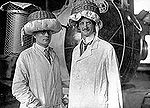 Auguste Piccard (on the right), physicist, inventor and explorer was a resident of Lausanne
Auguste Piccard (on the right), physicist, inventor and explorer was a resident of Lausanne
Lausanne is the birthplace of:- James Thiérrée, Actor
- David Bennent, Actor
- Metropolitan Anthony (Bloom) of Sourozh, Russian Orthodox ecclesiastic located in Britain
- François-Louis David Bocion, Swiss artist and teacher
- Johann Ludwig Burckhardt, Swiss traveler and orientalist
- Alejo Carpentier, Cuban-French writer
- Stéphane Chapuisat, Footballer
- Albert Chavannes, Philosopher
- Benjamin Constant, Swiss thinker, writer and French politician
- Aloise Corbaz, Swiss outsider artist
- Charles Dutoit, conductor
- Egon von Furstenberg, fashion designer
- Eugène Grasset, Swiss decorative artist
- Bertrand Piccard, Swiss psychiatrist and balloonist
- Charles Ferdinand Ramuz, Swiss writer
- Ubol Ratana, Thai princess
- Théophile Steinlen, Art Nouveau painter and printmaker
- Elizabeth Thompson (Lady Butler), British painter
- Bernard Tschumi, contemporary architect, writer, and educator
- Nanos Valaoritis Greek poet
- Félix Vallotton, post-impressionist painter
- Vincent Perez, film actor and director
- Stanislas Wawrinka, Swiss Tennis player
- Jocelyn Wildenstein, Manhattan socialite and ex-wife of the late Alec N. Wildenstein
- Ludovic Magnin, footballer
Notable residents:
- Pierre Amoyal, Paris-born violinist; professor at Lausanne Conservatory
- Jean Anouilh, French dramatist
- Ingvar Kamprad, Founder of IKEA
- Alice Bailly, Swiss painter and multimedia artist
- Maurice Béjart, choreographer
- Lorik Cana, Professional Footballer for Albania and Marseille
- Capucine, French actress and model
- Coco Chanel, fashion designer
- Pierre de Coubertin, French baron and IOC founder
- Jean-Pascal Delamuraz, Swiss politician
- Helen of Greece and Denmark, Queen Mother of Romania
- Victoria Eugenia of Battenberg, queen of Spain
- Peter Carl Fabergé, Russian jeweller
- Edward Gibbon, British historian
- Gloria Guinness, socialite and writer.
- Ravi Gupta, American-born scholar
- Oswald Heer, Swiss geologist and naturalist
- Stéphane Lambiel, men's figure skater and 2-time World Champion
- Sébastien Loeb, French rally driver
- Carl Gustav Emil Mannerheim, Finnish president and field marshal
- James Mason, English actor
- Fernand Melgar, Swiss actor
- Jô Soares, Brazilian humorist
- Waldemar Mordecai Haffkine, Ukrainian bacteriologist
- Paloma Picasso, Fashion designer
- Auguste Piccard, Swiss physicist, inventor and explorer
- George Sanders, English actor
- Albin Schram, Renowned manuscript collector
- Georges Simenon, Belgian writer
- Han Suyin, China-born writer
- Karol Szymanowski, Polish composer
- Eugène Viollet-le-Duc, French architect
- Pierre Viret, Swiss reformed theologian
- Serge Voronoff, Surgeon buried in Lausanne
See also
- Beau-Rivage Palace
- Eurovision Song Contest 1989
- Franco-Provençal language
- International Academy of Sport Science and Technology (AISTS)
- Lac de Sauvabelin
- Lausanne Conference, 1949
- List of mayors of Lausanne
- Scots Kirk, Lausanne (Church of Scotland)
- Treaty of Lausanne
References
- ^ a b c Swiss Federal Statistical Office, MS Excel document – Bilanz der ständigen Wohnbevölkerung nach Kantonen, Bezirken und Gemeinden (German) accessed 25 August 2010
- ^ Arealstatistik Standard - Gemeindedaten nach 4 Hauptbereichen
- ^ Clarey, Christopher. "Introduction to Lausanne". The New York Times. http://travel.nytimes.com/travel/guides/europe/switzerland/lausanne/overview.html?st=cse&sq=Lausanne&scp=3. Retrieved 2008-04-20.
- ^ Swiss Federal Statistical Office MS Excel document - Bilanz der ständigen Wohnbevölkerung (Total) nach Agglomerationen (German) accessed 21 June 2011
- ^ "Welcome to International Sports Federations". International Sports Federations. http://www.ifsports-guide.ch/english/navigation/bienvenue_en.html. Retrieved 2009-09-27.
- ^ Lousonna in German, French and Italian in the online Historical Dictionary of Switzerland.
- ^ a b c Lausanne in German, French and Italian in the online Historical Dictionary of Switzerland.
- ^ Lasserre, Claude (1997) (in French). Le séminaire de Lausanne, 1726-1812 : instrument de la restauration du protestantisme français : étude historique fondée principalement sur les documents inédits. Bibliothèque historique vaudoise, no 112. Lausanne: Bibliothèque historique vaudoise. ISBN 9782884541121. OCLC 39222660. Also OCLC 39228676
- ^ Lausanne District 1313-2006 in German, French and Italian in the online Historical Dictionary of Switzerland.
- ^ "Lausanne 1964: Two ideas, one Expo". Swiss National Exhibitions - Expo-Archive. swissinfo/Swiss Radio International (SRI). http://www.expo-archive.ch/eng/index.html?siteSect=1000. Retrieved 2009-09-27.
- ^ a b Swiss Federal Statistical Office-Land Use Statistics 2009 data (German) accessed 25 March 2010
- ^ Nomenklaturen – Amtliches Gemeindeverzeichnis der Schweiz (German) accessed 4 April 2011
- ^ Flags of the World.com accessed 21-June-2011
- ^ a b Swiss Federal Statistical Office - Superweb database - Gemeinde Statistics 1981-2008 (German) accessed 19 June 2010
- ^ a b c d e f g Swiss Federal Statistical Office accessed 21-June-2011
- ^ a b c d e f STAT-TAB Datenwürfel für Thema 40.3 - 2000 (German) accessed 2 February 2011
- ^ Canton of Vaud Statistical Office (French) accessed 29 April 2011
- ^ Eurostat. "Housing (SA1)" (pdf). Urban Audit Glossary. 2007. p. 18. http://www.bfs.admin.ch/bfs/portal/en/index/international/22/lexi.Document.116365.pdf. Retrieved 12 February 2010.
- ^ Urban Audit Glossary pg 17
- ^ a b Swiss Federal Statistical Office STAT-TAB - Datenwürfel für Thema 09.2 - Gebäude und Wohnungen (German) accessed 28 January 2011
- ^ Swiss Federal Statistical Office-Rental prices 2003 data (German) accessed 26 May 2010
- ^ [1]
- ^ Canton de Vaud: Election au Conseil national du 23 octobre 2011 (French) accessed 2 Nov 2011
- ^ Swiss Federal Statistical Office STAT-TAB Betriebszählung: Arbeitsstätten nach Gemeinde und NOGA 2008 (Abschnitte), Sektoren 1-3 (German) accessed 28 January 2011
- ^ a b Swiss Federal Statistical Office - Statweb (German) accessed 24 June 2010
- ^ "Where to find us." Philip Morris International. Retrieved on 19 October 2009.
- ^ "Temperature and Precipitation Average Values-Table, 1961-1990" (in German, French, Italian). Federal Office of Meteorology and Climatology - MeteoSwiss. http://www.meteoswiss.admin.ch/web/de/klima/klima_schweiz/tabellen.html. Retrieved 8 May 2009., the Lausanne weather station elevation is 601 meters above sea level.
- ^ Organigramme de l'école vaudoise, année scolaire 2009-2010 (French) accessed 2 May 2011
- ^ Canton of Vaud Statistical Office - Scol. obligatoire/filières de transition (French) accessed 2 May 2011
- ^ a b Canton of Vaud Statistical Office - Fréquentation de quelques musées et fondations, Vaud, 2001-2009 (French) accessed 2 May 2011
- ^ Swiss Federal Statistical Office, list of libraries (German) accessed 14 May 2010
- ^ "Kantonsliste A-Objekte" (in German). KGS Inventar. Federal Office of Civil Protection. 2009. http://www.bevoelkerungsschutz.admin.ch/internet/bs/de/home/themen/kgs/kgs_inventar/a-objekte.html. Retrieved 25 April 2011.
- ^ http://www.internationalbandy.com/viewNavMenu.do?menuID=69
- ^ http://www.stadelausannerugby.com
- ^ http://www.flyhigh.ultimate.ch/fr/Accueil.html
External links
- International Academy of Sports Science and Technology (AISTS)
- City of Lausanne, official site
- The official tourism homepage of Lausanne
- Map of Lausanne
- Map of public transport
- Lausanne in German, French and Italian in the online Historical Dictionary of Switzerland.
- Lausanne travel guide from Wikitravel
Municipalities in the district of Lausanne, Switzerland 
Capitals of Swiss cantons Cities in Switzerland by population 300,000+ 
100,000+ Basel · Bern · Geneva · Lausanne · Winterthur
30,000+ Bienne · Chur · Fribourg · Köniz · La Chaux-de-Fonds · Lucerne · Lugano · Neuchâtel · St. Gallen · Schaffhausen · Thun · Uster · Vernier
15,000+ Aarau · Adliswil · Allschwil · Baar · Baden · Bellinzona · Burgdorf · Carouge · Dietikon · Emmen · Frauenfeld · Gossau · Grenchen · Herisau · Horgen · Kloten · Kreuzlingen · Kriens · Lancy · Littau · Locarno · Meyrin · Monthey · Montreux · Muttenz · Olten · Onex · Ostermundigen · Pratteln · Rapperswil-Jona · Regensdorf · Renens · Schwyz · Sierre · Sion · Solothurn · Spiez · Steffisburg · Thalwil · Vevey · Volketswil · Wädenswil · Wettingen · Wetzikon · Wil · Yverdon-les-Bains · Zollikon · Zug
Categories:- Municipalities of the canton of Vaud
- Municipalities of Switzerland
- Lausanne
- Cantonal capitals of Switzerland
- Cities in Switzerland
- Vaud
- Cultural property of national significance in the canton of Vaud
Wikimedia Foundation. 2010.

